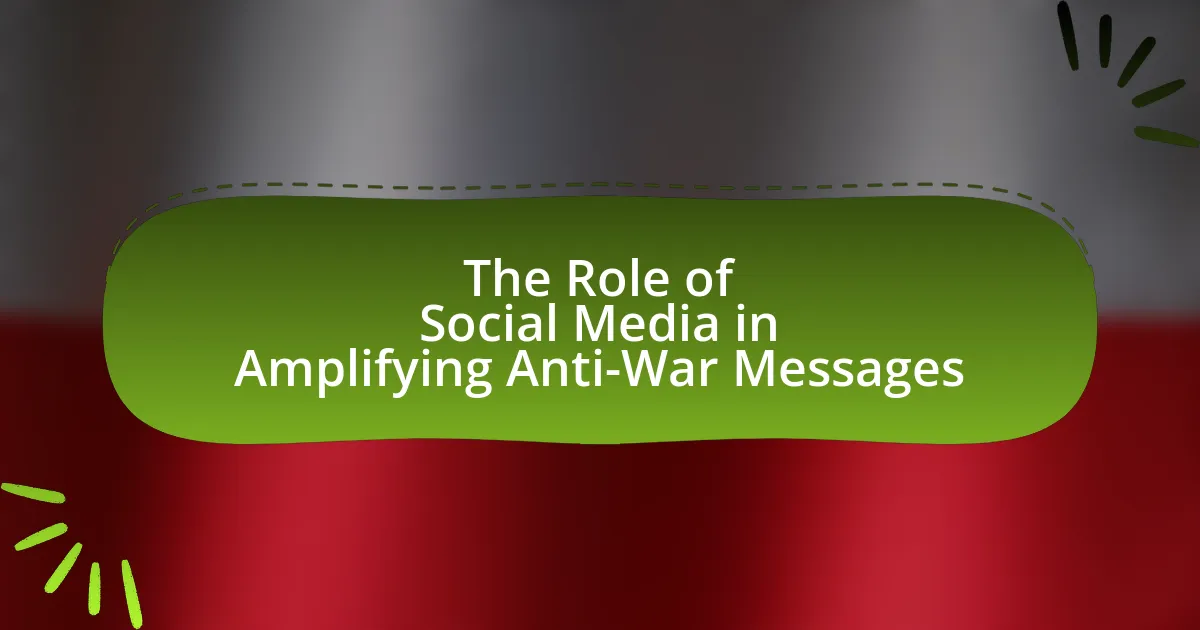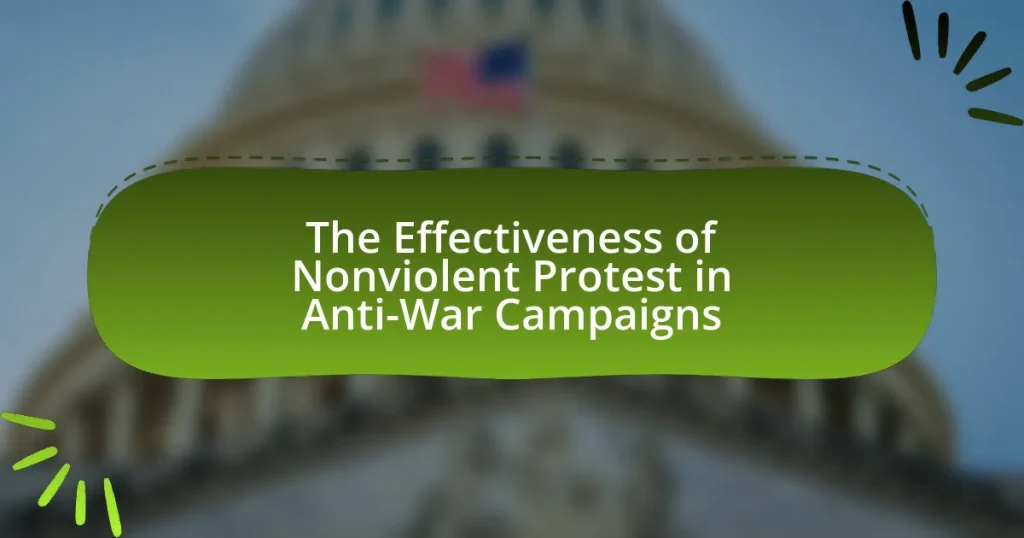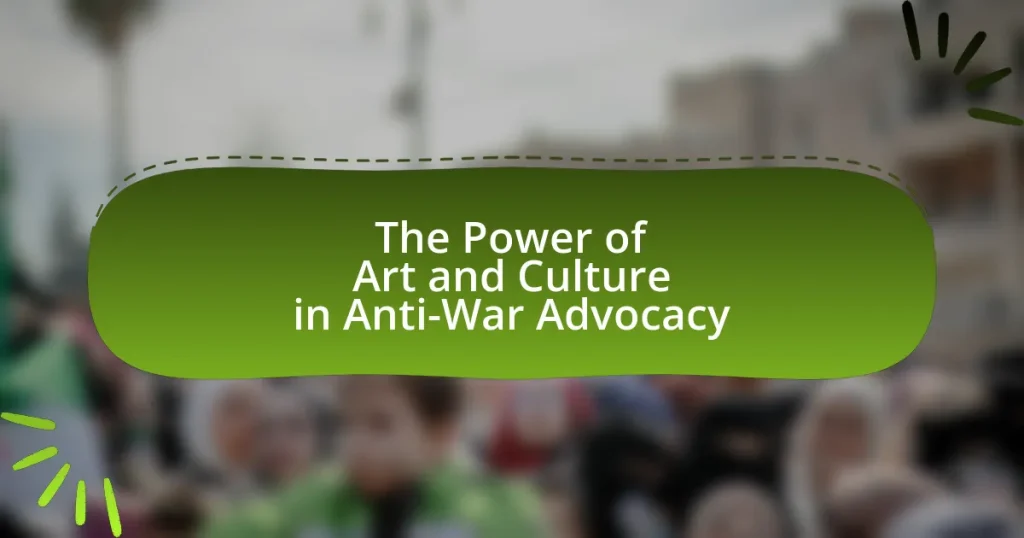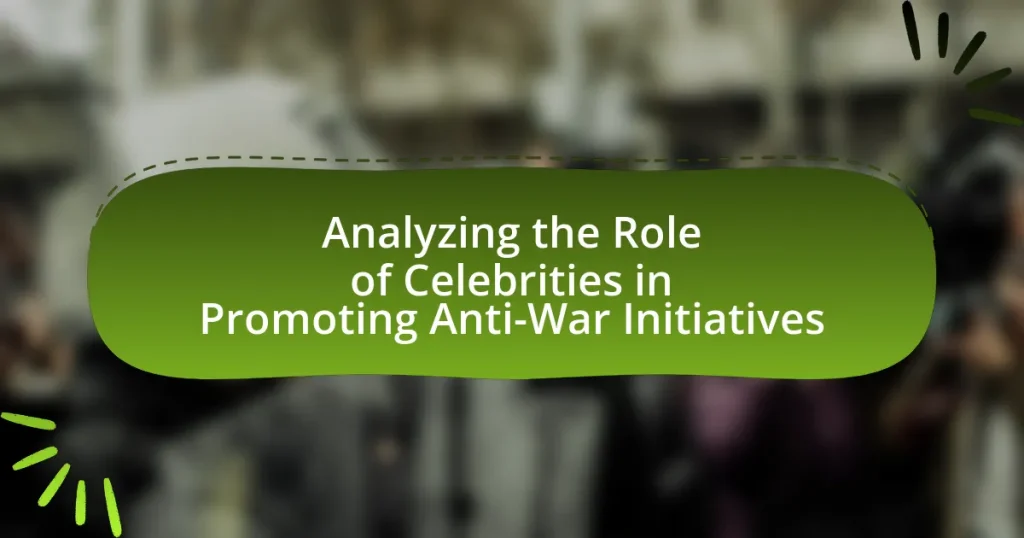The article examines the significant role of social media in amplifying anti-war messages, highlighting how platforms like Twitter, Facebook, and Instagram facilitate rapid information dissemination and grassroots mobilization. It discusses the effectiveness of these platforms in organizing protests, raising awareness, and influencing public opinion, particularly during historical events such as the Iraq War and the Arab Spring. Additionally, the article addresses challenges faced by anti-war narratives, including algorithmic bias, misinformation, and censorship, while exploring strategies for enhancing engagement and impact through targeted messaging, visuals, and community building. The analysis underscores the evolving landscape of activism in the digital age and the importance of ethical considerations in sharing anti-war content.
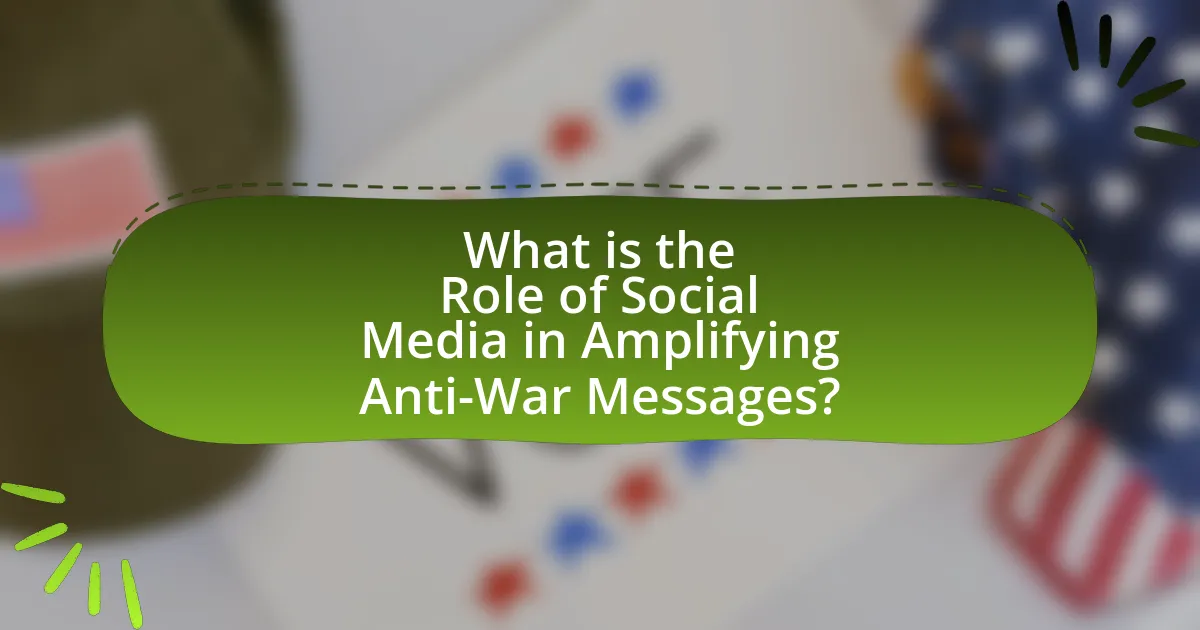
What is the Role of Social Media in Amplifying Anti-War Messages?
Social media plays a crucial role in amplifying anti-war messages by providing a platform for rapid dissemination and engagement. It enables individuals and organizations to share information, mobilize support, and foster community around anti-war sentiments. For instance, during the Iraq War, platforms like Twitter and Facebook facilitated grassroots movements, allowing activists to organize protests and share real-time updates, which significantly increased public awareness and opposition to the conflict. Studies have shown that social media campaigns can reach millions quickly, making them effective tools for influencing public opinion and policy regarding war.
How does social media facilitate the spread of anti-war messages?
Social media facilitates the spread of anti-war messages by providing a platform for rapid information dissemination and community engagement. Users can share content, such as articles, videos, and personal stories, which can quickly reach a wide audience, often surpassing traditional media channels. For instance, during the Iraq War, platforms like Twitter and Facebook were instrumental in organizing protests and sharing real-time updates, allowing activists to mobilize support and raise awareness effectively. Studies have shown that social media campaigns can significantly influence public opinion, as seen in the 2017 Women’s March, which highlighted anti-war sentiments among various social justice issues.
What platforms are most effective for sharing anti-war content?
Social media platforms such as Twitter, Facebook, and Instagram are most effective for sharing anti-war content. These platforms enable rapid dissemination of information and facilitate engagement through likes, shares, and comments, amplifying the reach of anti-war messages. For instance, Twitter’s character limit encourages concise messaging, while Facebook’s groups and event features allow for community organization and mobilization around anti-war initiatives. Research indicates that social media campaigns can significantly influence public opinion, as seen during the 2003 Iraq War protests, where online mobilization played a crucial role in gathering support and organizing demonstrations.
How do algorithms influence the visibility of anti-war messages?
Algorithms significantly influence the visibility of anti-war messages by determining which content is prioritized in users’ feeds based on engagement metrics. Social media platforms like Facebook and Twitter utilize algorithms that favor posts with higher interaction rates, meaning that anti-war messages that resonate with users, garner likes, shares, and comments are more likely to be seen by a broader audience. For instance, a study by the Pew Research Center found that content that sparks emotional responses tends to be shared more widely, thus increasing its visibility. Consequently, if anti-war messages evoke strong reactions, they are more likely to be amplified through these algorithms, reaching users who may not actively seek out such content.
Why is social media a powerful tool for anti-war activism?
Social media is a powerful tool for anti-war activism because it enables rapid dissemination of information and mobilization of supporters. Platforms like Twitter and Facebook allow activists to share real-time updates, organize protests, and amplify their messages to a global audience. For instance, during the 2011 Arab Spring, social media played a crucial role in coordinating protests against oppressive regimes, demonstrating its effectiveness in fostering collective action. Additionally, studies show that social media campaigns can significantly increase public awareness and engagement on issues related to war, as seen in the #NoWar movement, which gained traction and influenced public opinion against military interventions.
What are the unique features of social media that support activism?
Social media uniquely supports activism through its ability to facilitate rapid information dissemination, foster community engagement, and enable grassroots organizing. These platforms allow activists to share messages instantly with a global audience, as evidenced by the Arab Spring in 2011, where social media played a crucial role in mobilizing protests and spreading awareness. Additionally, social media provides tools for community building, allowing like-minded individuals to connect and collaborate, which was evident during the Black Lives Matter movement, where hashtags and online campaigns galvanized support and action. Furthermore, social media enables grassroots organizing by allowing users to create events, share resources, and coordinate efforts efficiently, exemplified by the Women’s March in 2017, which saw millions participate worldwide due to effective online mobilization.
How does social media enable grassroots movements?
Social media enables grassroots movements by providing a platform for rapid communication and mobilization among individuals with shared interests. This immediacy allows activists to organize events, share information, and rally support quickly, often leading to significant participation in protests or campaigns. For instance, the Arab Spring demonstrated how platforms like Twitter and Facebook facilitated the coordination of protests, resulting in widespread political change across multiple countries. Additionally, social media’s ability to reach a global audience amplifies local issues, drawing international attention and support, which can further strengthen grassroots efforts.
What challenges do anti-war messages face on social media?
Anti-war messages face significant challenges on social media, primarily due to algorithmic bias and misinformation. Social media platforms often prioritize content that generates higher engagement, which can lead to the suppression of anti-war narratives in favor of more sensational or divisive content. For instance, a study by the Pew Research Center found that misinformation spreads faster and more widely than factual information, making it difficult for anti-war messages to gain traction. Additionally, users may encounter echo chambers that reinforce pro-war sentiments, limiting exposure to diverse viewpoints. These factors collectively hinder the visibility and impact of anti-war messages on social media platforms.
How do misinformation and propaganda impact anti-war narratives?
Misinformation and propaganda significantly distort anti-war narratives by shaping public perception and influencing emotional responses. For instance, false information can create a sense of urgency or fear, leading individuals to support or oppose military actions based on inaccurate portrayals of events. A study by the Oxford Internet Institute found that misinformation spread through social media can amplify divisive narratives, undermining trust in legitimate anti-war movements. This manipulation of information can result in polarized opinions, where genuine anti-war sentiments are overshadowed by fabricated claims, ultimately affecting the effectiveness and credibility of grassroots campaigns against war.
What role do censorship and platform policies play in limiting anti-war discourse?
Censorship and platform policies significantly limit anti-war discourse by restricting the visibility and dissemination of anti-war content. Social media platforms often implement guidelines that classify certain anti-war messages as harmful or misleading, leading to content removal or account suspension. For instance, during the Iraq War, platforms like Facebook and Twitter faced criticism for removing posts that opposed military actions, citing violations of community standards. This suppression creates an environment where dissenting voices struggle to reach wider audiences, ultimately stifling public debate and awareness regarding anti-war sentiments.
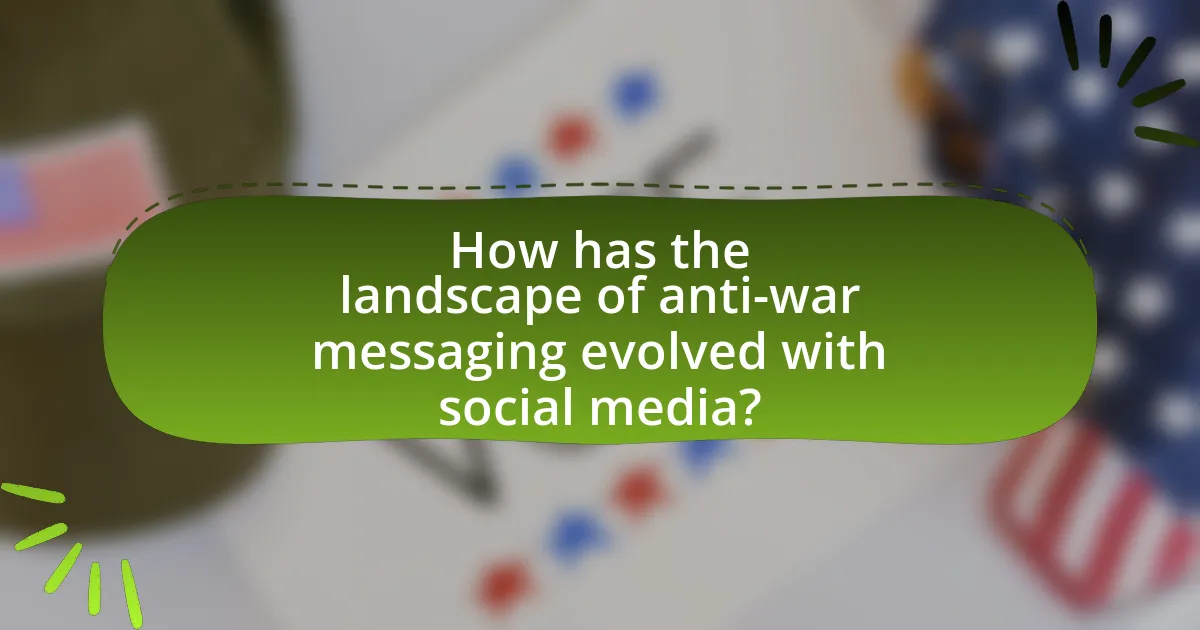
How has the landscape of anti-war messaging evolved with social media?
The landscape of anti-war messaging has evolved significantly with social media by enabling rapid dissemination and grassroots mobilization. Social media platforms like Twitter, Facebook, and Instagram allow individuals and organizations to share anti-war content instantly, reaching a global audience without traditional media gatekeeping. For instance, during the Iraq War, hashtags such as #NoWar and #StopTheWar became rallying points for activists, facilitating coordinated protests and awareness campaigns. Research indicates that social media has increased public engagement in anti-war movements, with a 2019 study by the Pew Research Center showing that 69% of Americans believe social media is an effective tool for political activism. This evolution reflects a shift from centralized messaging to decentralized, user-generated content, empowering diverse voices in the anti-war discourse.
What historical context is important for understanding this evolution?
The historical context important for understanding the evolution of social media’s role in amplifying anti-war messages includes the rise of digital communication technologies and significant anti-war movements. The Vietnam War era in the 1960s and 1970s marked a pivotal moment when grassroots activism utilized emerging media, such as television and print, to mobilize public opinion against the war. This laid the groundwork for later movements. The advent of social media platforms in the early 2000s, particularly during conflicts like the Iraq War, enabled rapid dissemination of information and grassroots organizing, exemplified by campaigns like “Stop the War Coalition” in the UK. These platforms facilitated real-time communication and engagement, allowing activists to reach wider audiences and coordinate protests effectively. The Arab Spring in 2010 further demonstrated social media’s power in mobilizing anti-government sentiments, showcasing its potential to amplify anti-war messages globally.
How did traditional media compare to social media in past anti-war movements?
Traditional media, such as newspapers and television, primarily served as gatekeepers of information during past anti-war movements, whereas social media platforms enabled direct and immediate communication among activists. Traditional media often filtered and framed narratives, which could lead to biased representations of anti-war sentiments, as seen during the Vietnam War when coverage was limited and controlled by major networks. In contrast, social media allowed for grassroots mobilization and the rapid dissemination of unfiltered information, exemplified by the widespread use of platforms like Twitter and Facebook during the Iraq War protests in the early 2000s, where activists could share real-time updates and organize events without traditional media’s constraints. This shift significantly altered the landscape of activism, empowering individuals to bypass traditional media’s limitations and directly engage with a global audience.
What significant events have shaped the current use of social media for anti-war messages?
The significant events that have shaped the current use of social media for anti-war messages include the Iraq War, the Arab Spring, and the ongoing conflict in Ukraine. The Iraq War (2003) marked a pivotal moment as social media platforms like Facebook and Twitter emerged, allowing activists to organize protests and share anti-war sentiments rapidly. The Arab Spring (2010-2012) further demonstrated the power of social media in mobilizing large-scale protests against oppressive regimes, showcasing how these platforms could amplify dissent and anti-war messages globally. More recently, the conflict in Ukraine (beginning in 2014) has seen extensive use of social media to disseminate information, counter misinformation, and rally international support against military aggression, reinforcing the role of these platforms in shaping public discourse around war and peace.
How do different demographics engage with anti-war messages on social media?
Different demographics engage with anti-war messages on social media through varying levels of interaction, sharing, and content creation. Younger individuals, particularly those aged 18-29, tend to engage more actively by sharing posts, creating memes, and participating in online discussions, as evidenced by a Pew Research Center study indicating that 71% of this age group uses social media for political engagement. In contrast, older demographics, such as those aged 50 and above, may engage less frequently but often share content that aligns with their established beliefs, reflecting a more passive consumption pattern. Additionally, racial and ethnic minorities often utilize social media to amplify their unique perspectives on anti-war sentiments, with studies showing that Black and Hispanic users are more likely to engage in activism online compared to their white counterparts. This engagement is further influenced by factors such as educational background and socio-economic status, which shape individuals’ access to information and their willingness to participate in online activism.
What age groups are most active in sharing anti-war content?
Individuals aged 18 to 29 are the most active in sharing anti-war content on social media platforms. This age group is characterized by high engagement with digital media, often utilizing platforms like Twitter, Instagram, and TikTok to express their views. Research indicates that younger users are more likely to participate in social movements online, with studies showing that 70% of individuals in this demographic have shared political content, including anti-war messages, within the past year.
How do cultural backgrounds influence the reception of anti-war messages?
Cultural backgrounds significantly influence the reception of anti-war messages by shaping individuals’ values, beliefs, and historical contexts. For instance, societies with a history of militarism may be more resistant to anti-war sentiments, while cultures that prioritize peace and diplomacy are more likely to embrace such messages. Research indicates that collective memory and national identity, which are deeply rooted in cultural backgrounds, affect how people interpret and respond to anti-war narratives. A study by the Pew Research Center found that individuals from countries with recent experiences of conflict are more receptive to anti-war messages, as they resonate with their lived experiences and societal values.

What strategies can enhance the effectiveness of anti-war messages on social media?
Utilizing targeted messaging, engaging visuals, and leveraging influential voices can significantly enhance the effectiveness of anti-war messages on social media. Targeted messaging ensures that the content resonates with specific demographics, increasing the likelihood of engagement; for instance, research indicates that tailored messages can improve response rates by up to 50%. Engaging visuals, such as infographics and videos, capture attention more effectively than text alone, as studies show that posts with images receive 94% more views. Additionally, leveraging influential voices, such as activists or public figures, can amplify reach and credibility, as endorsements from trusted individuals can increase message acceptance by 70%. These strategies collectively contribute to a more impactful dissemination of anti-war sentiments on social media platforms.
What types of content resonate most with audiences?
Visual content, such as videos and infographics, resonates most with audiences. Research indicates that visual content is processed 60,000 times faster than text, making it more engaging and shareable on social media platforms. Additionally, a study by HubSpot found that posts with images receive 94% more views than those without, highlighting the effectiveness of visual storytelling in conveying anti-war messages.
How can visuals and storytelling improve engagement with anti-war messages?
Visuals and storytelling enhance engagement with anti-war messages by making complex issues more relatable and emotionally resonant. Research indicates that visual content, such as images and videos, captures attention more effectively than text alone, leading to higher retention rates of the message. For instance, a study by the Pew Research Center found that social media posts with images receive 94% more views than those without. Additionally, storytelling creates a narrative that allows individuals to connect personally with the experiences of those affected by war, fostering empathy and a deeper understanding of the consequences of conflict. This combination of visual appeal and narrative depth significantly increases the likelihood of sharing and discussing anti-war messages on social media platforms.
What role do hashtags and trends play in amplifying these messages?
Hashtags and trends significantly amplify anti-war messages by increasing their visibility and engagement across social media platforms. When users employ specific hashtags related to anti-war sentiments, these tags categorize the content, making it easier for others to discover and join the conversation. For instance, during the 2022 protests against the war in Ukraine, hashtags like #StandWithUkraine trended globally, leading to millions of posts and interactions, which in turn raised awareness and mobilized support. This phenomenon demonstrates how trending topics can create a collective voice, drawing attention from mainstream media and influencing public opinion.
How can activists measure the impact of their anti-war campaigns on social media?
Activists can measure the impact of their anti-war campaigns on social media by analyzing engagement metrics such as likes, shares, comments, and reach. These metrics provide quantitative data on how many people interacted with the content, indicating its resonance and effectiveness. For instance, a study by the Pew Research Center found that social media posts with higher engagement rates correlate with increased awareness and mobilization around social issues. Additionally, sentiment analysis tools can assess public opinion by evaluating the tone of comments and discussions related to the campaign, offering insights into the emotional response of the audience. By combining these quantitative and qualitative measures, activists can effectively gauge the success and influence of their anti-war messaging on social media platforms.
What metrics are most useful for assessing engagement and reach?
The most useful metrics for assessing engagement and reach are impressions, engagement rate, reach, and shares. Impressions indicate how many times content is displayed, while reach measures the total number of unique users who see the content. The engagement rate, calculated by dividing the total interactions (likes, comments, shares) by the total impressions, provides insight into how effectively the content resonates with the audience. Shares are particularly significant as they reflect the willingness of users to distribute the content within their networks, amplifying its reach. These metrics collectively offer a comprehensive view of how well anti-war messages are being disseminated and engaged with on social media platforms.
How can feedback from social media users inform future strategies?
Feedback from social media users can inform future strategies by providing real-time insights into public sentiment and preferences regarding anti-war messages. Analyzing user comments, shares, and reactions allows organizations to identify which messages resonate most effectively with their audience. For instance, a study by the Pew Research Center found that 64% of social media users engage with political content, indicating that user interactions can reveal critical trends and opinions. By leveraging this data, organizations can tailor their messaging, optimize content delivery, and enhance engagement strategies to better align with the values and concerns of their audience.
What best practices should activists follow when using social media for anti-war messaging?
Activists should prioritize clarity, authenticity, and engagement when using social media for anti-war messaging. Clear messaging ensures that the audience understands the core message, while authenticity builds trust and credibility. Engaging with followers through comments and discussions fosters a sense of community and encourages further sharing of the message.
Additionally, utilizing visuals such as infographics and videos can enhance the impact of the message, as studies show that posts with images receive 94% more views than those without. Consistently using relevant hashtags can also increase visibility and reach, as hashtags can connect posts to broader conversations.
Furthermore, activists should monitor and respond to misinformation promptly, as addressing false narratives can strengthen the movement’s credibility. Collaborating with other organizations can amplify the message and broaden the audience. These best practices collectively enhance the effectiveness of anti-war messaging on social media platforms.
How can activists ensure their messages are clear and impactful?
Activists can ensure their messages are clear and impactful by using concise language, focusing on a single core message, and employing visual elements to enhance understanding. Research indicates that messages with a clear focus are 40% more likely to be remembered by audiences, as shown in studies on communication effectiveness. Additionally, utilizing social media platforms allows activists to reach a broader audience quickly, with statistics revealing that visual content is shared 40 times more on social media than other types of content. By combining clarity in messaging with effective use of visuals and social media, activists can significantly enhance the impact of their communications.
What ethical considerations should be taken into account when sharing anti-war content?
When sharing anti-war content, it is essential to consider the potential impact on public perception and the emotional well-being of individuals affected by conflict. Ethical considerations include ensuring accuracy to prevent misinformation, respecting the dignity of victims by avoiding sensationalism, and being mindful of the potential for inciting violence or hatred. For instance, the spread of false information can lead to public panic or misinformed actions, as seen in various conflicts where misinformation exacerbated tensions. Additionally, content should be shared with sensitivity to the experiences of those directly impacted by war, as exploitative narratives can further harm vulnerable populations.
